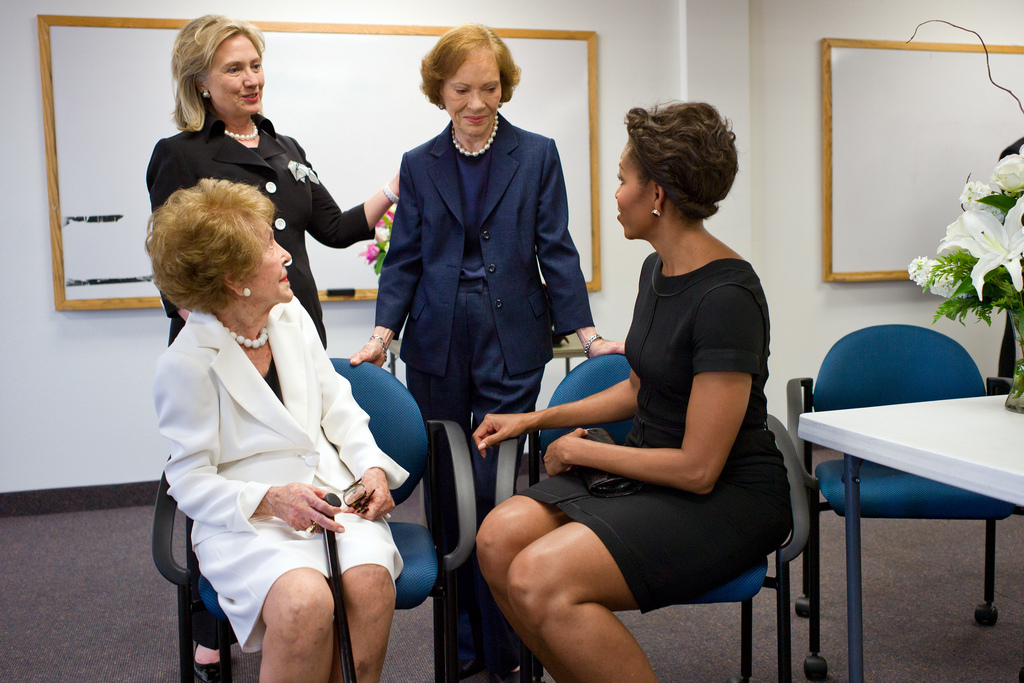
Hillary Clinton, Rosalynn Carter, Nancy Reagan and Michelle Obama together attended the California desert after t services for Betty Ford in 2011.
When the plans were announced for Nancy Reagan’s Friday, March 11, 2016 funeral and burial at the Ronald Reagan Presidential Library in Simi Valley, five days after her death, came word that four of her five living fellow First Ladies would be in attendance: Michelle Obama, Laura Bush, Hillary Clinton and Rosalynn Carter. The only living First Lady who would not attend was Barbara Bush.
Mrs. Reagan’s funeral gathering continued a tradition unbroken for all of her predecessors who had served as First Ladies since 1933, beginning with Eleanor Roosevelt. However, a closer examination of the circumstances of each of these gatherings tells a more nuanced, somewhat haphazard history.
On only one known occasion before the funeral of Mrs. Roosevelt had a First Lady been honored by one of the small sorority of women who have been married to U.S. Presidents and who served in that unsalaried, unofficial yet publicly expected role of First Lady. Like Eleanor Roosevelt, that earlier First Lady was one held as the standard against which all her successors were judged, Dolley Madison.
Having retired to Washington, D.C. and living across the street from the White House, Mrs. Madison was honored at her July 16, 1849 funeral with the presence of her friend and fellow former First Lady Louisa Adams. Almost certainly also in attendance was the incumbent First Lady Peggy Taylor, who worshipped daily at St. John’s Church where the funeral was held, and whose husband, the incumbent President Zachary Taylor, also attended.
It was, however, the funeral of Eleanor Roosevelt that seems to have set in motion the modern tradition of First Ladies being honored by others who have had the challenge of interpreting a puzzling role in a way that manages to permit them to remain authentic, support the administration of their spouse and initiate effective, positive change for ignored demographics.
Eleanor Roosevelt
November 10, 1962, Hyde Park, New York
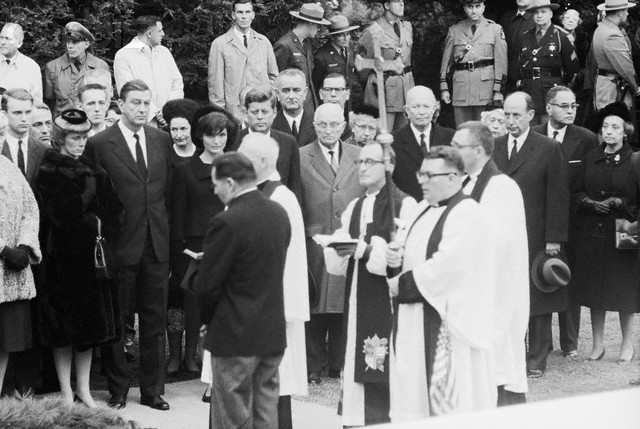
Three Presidents were among mourners at graveside services for Eleanor Roosevelt at Roosevelt esate in Hyde Park, New York. From left to right are Jacqueline Kennedy, President John F. Kennedy, Vice President Lyndon B. Johnson, former President Harry S. Truman, Bess Truman, and former President Dwight D. Eisenhower. (Corbis)
Eleanor Roosevelt, serving as First Lady for an unprecedented twelve years and using every means of media to initiate and continue a national dialogue during the dark days of the Great Depression and World War II, became a nation figure in her own right. Also, like Mrs. Madison, Mrs. Roosevelt remained active in national life after her time in the White House. In the case of the latter she became a leading and powerful voice within the liberal wing of the national Democratic Party and a passionate advocate for equal rights regardless of gender or color.
While it is easy to presume that those who attended her funeral did so due to her having achieved a near mythical status in the imagination of the nation, much as had Dolley Madison, it was less a matter of honoring the position of First Lady than it was of paying homage to Eleanor Roosevelt.
As a presidential widow, Mrs. Roosevelt had forged alliances with the Democratic presidential successors to her husband. President Harry Truman named her a delegate to the United Nations and President John F. Kennedy made her chair of his Commission on the Status of Women.
She also had a close relationship with the Senate Majority Leader during the 1950s, Lyndon B. Johnson, who would become President of the United States just a year and two weeks after her death. Former President Dwight Eisenhower also attended; his presence might have seemed curious, given the fact that throughout his two terms as president, Mrs. Roosevelt was highly critical of many of his decisions. It might be supposed that the Republican President and former may have attended more as a matter of respect for the late Franklin D. Roosevelt, his commander-in-chief when Eisenhower was Supreme Commander of the Allied Forces during World War II. He had also been on friendly terms with Mrs. Roosevelt as widow, from 1945 to 1952.
Thus it was that Eleanor Roosevelt’s funeral and burial were attended by former President Truman, incumbent President Kennedy, and future President Johnson. As was the custom in that era, the wives of all three men – Bess Truman, Jacqueline Kennedy, and Lady Bird Johnson – accompanied their husbands. Mamie Eisenhower did not join her husband, not out of partisanship but because she was unwell at the time. Another fact seems to suggest that the presence of two of her successors (and one future successor) was not intended as a gathering to honor her as a First Lady but as a national figure.
Just a year earlier, Edith Wilson had died; her funeral and burial took place right in Washington, D.C. just a few miles from the White House. She had long been close to both Eleanor Roosevelt, who lived in New York City, and Mamie Eisenhower, who lived not far away, in Gettysburg, Pennsylvania. She had also been an enthusiastic supporter of the incumbent First Lady, Jacqueline Kennedy. Mrs. Wilson also had a national reputation, spending nearly four decades as the keeper of her late husband’s legacy and as a popular representative of him within the Democratic Party. Nonetheless, none of the four living First Ladies at the time (Roosevelt, Truman, Eisenhower, Kennedy) attended her funeral.
Mamie Eisenhower
November 3, 1979, Abilene, Kansas
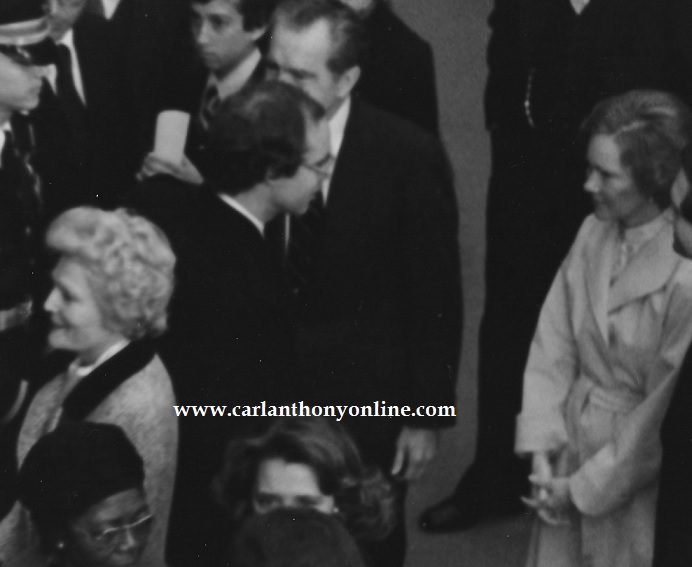
Pat Nixon (lower left), Richard Nixon (partially obscured, center) Rosalynn Carter (white coat, at right), gather for Mamie Eisenhower’s 1979 funeral, with members of her family.
Strictly adhering to a policy of not speaking out on controversial political and social issues during her eight years as First Lady, Mamie Eisenhower occupied a more sentimental but far less legendary place in the minds of Americans at the time of her death in 1979. The fact that former First Lady Pat Nixon attended her funeral seemed to be an act less of a successor honoring a predecessor than a highly personal decision. The two women had been extremely close during the two Eisenhower terms when Mrs. Eisenhower befriended the younger Mrs. Nixon who, as wife of Eisenhower’s Vice President, often assumed ceremonial duties on her behalf. Too, they were family, Mamie’s grandson having married Pat’s daughter. Even had these not been factors, it would have unusual for her to be there accompanying her husband, former president Richard Nixon since he had been, as stated Eisenhower’s Vice President for eight years.
It was, however, the presence at Mrs. Eisenhower’s funeral and burial of the incumbent First Lady, Rosalynn Carter, that is the overlooked but important factor in establishing the tradition of former and incumbent First Ladies attending the funeral of one of their own. Several factors suggest that Mrs. Carter made a conscious decision to honor Mrs. Eisenhower for her role as the nation’s First Lady.
First, Mrs. Carter came on her own, without the President. Second, she was from the oppositional political party, and her presence thus signaled a motive transcending partisanship. Third, Mrs. Carter had only met Mrs. Eisenhower on one occasion, so there was no long link between them.
Those who did not attend were Jacqueline Kennedy Onassis, who was overseas at the time on travel related to her professional life as a book publishing editor and had not been personally close to Mrs. Eisenhower. Inexplicable were the absences of Lady Bird Johnson, who had been especially close to Mamie Eisenhower, and Betty Ford, who had been relatively close. Understandable was the absence of Bess Truman, who was then 94 years old and in frail health.
Bess Truman
October 21, 1982, Independence, Missouri
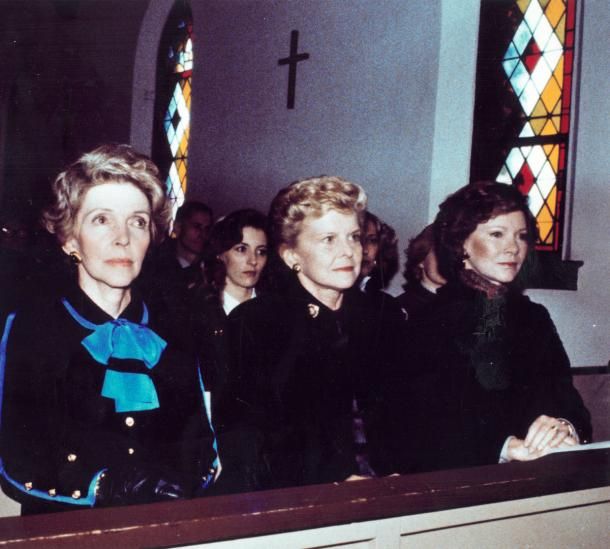
Nancy Reagan, Betty Ford and Rosalynn Carter attend the 1982 funeral of Bess Truman.
Bess Truman’s funeral was arranged by her only child Margaret Truman. Although she made a point of stating she did not invited former First Lady Rosalynn Carter, the latter did come to uphold the tradition. Invited and attending were former First Lady Betty Ford and incumbent Nancy Reagan. Also invited by absent were Jacqueline Kennedy Onassis, then in China on a work project, and Lady Bird Johnson, sequestered in Rochester, Minnesota at the Mayo Clinic for medical testing.
Pat Nixon
June 26, 1993, Yorba Linda, California
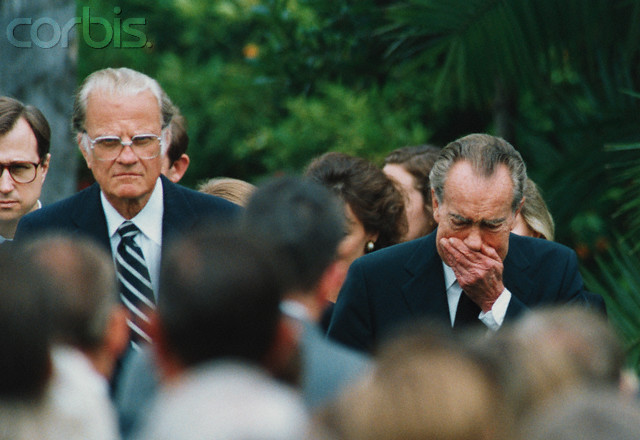
Reverend Billy Graham and a grieving Richard Nixon arrive at memorial services for former First Lady Pat Nixon, at the Nixon Presidential Library in Yorba Linda, California.
Although Pat Nixon was living in New Jersey at the time of her death, her funeral and burial were conducted at the Nixon Presidential Library in her native southern California. The two former First Ladies who lived relatively close, Betty Ford and Nancy Reagan were in attendance, along with their husbands and the widowed President Nixon. The incumbent First Lady Hillary Clinton sent regrets due to previously scheduled events involving her young daughter. Jacqueline Kennedy Onassis sent a letter to Mrs. Nixon shortly before her death, but did not attend the funeral, nor did the other living Democratic First Ladies, Rosalynn Carter and Lady Bird Johnson. Thus the guest list seemed to divide along partisan lines, which was unusual.
Jacqueline Kennedy Onassis
May 23, 1994, New York, New York
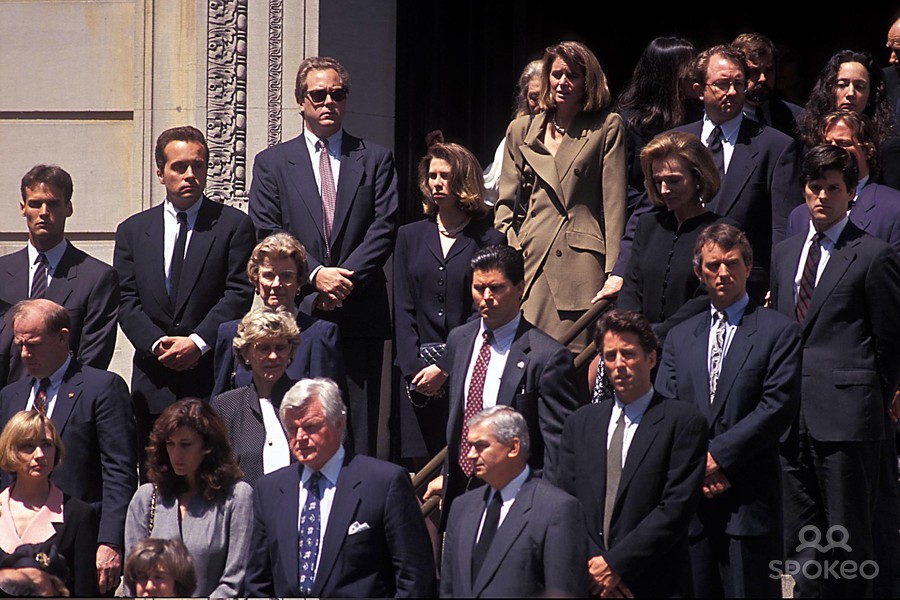
Mourners leave the funeral mass of Jackie Kennedy Onassis, including the incumbent First Lady Hillary Clinton, pictured in the far left corner.
Requesting of her children that her funeral guests be limited to those she considered herself personally close to, with as little official recognition as possible, the funeral mass of Jacqueline Kennedy Onassis was attended by incumbent First Lady Hillary Clinton and former First Lady Lady Bird Johnson. Mrs. Clinton would also join the close circle of friends and family at the Arlington National Cemetery burial.
Lady Bird Johnson
July 14, 2007, Austin, Texas
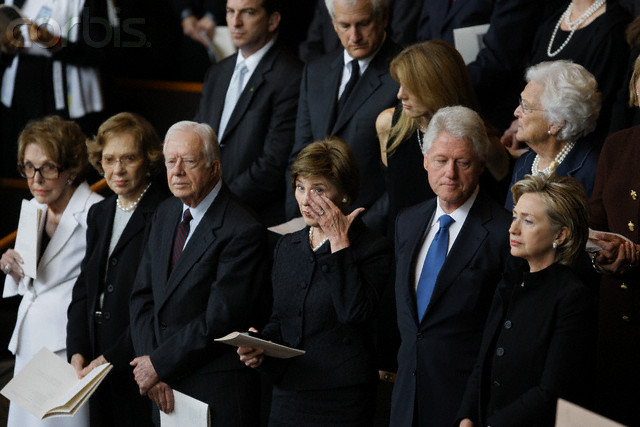
A record number of five First Ladies attended the funeral of Lady Bird Johnson, along with two former presidents. (Corbis)
Lady Bird Johnson, an especially strong friend to other First Ladies was honored when the largest number of them appeared at her funeral in Austin, Texas: Nancy Reagan, Rosalynn Carter, Barbara Bush, Laura Bush and Hillary Clinton. The only one missing was Betty Ford, who was too frail, having undergone surgery relatively recently before and still in mourning for the loss of her husband seven months earlier.
Betty Ford
July 12, 2011, Palm Desert, California and Grand Rapids, Michigan
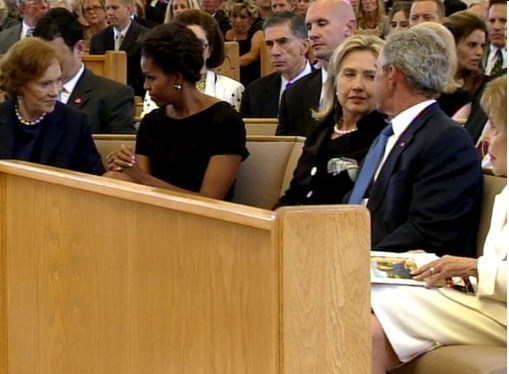
Four First Ladies and one President at Mrs. Ford’s funeral in the desert: Rosalyn Carter, Michelle Obama, Hillary Clinton, George W. Bush and Nancy Reagan.
Like Mrs. Johnson, Betty Ford had formed more than superficial bonds with the other First Ladies, and it was reflected in by the fact that all but one of the living First Ladies honored her by attending her funeral and burial. However, rather uniquely the two events were separated, the former held in Palm Desert, California, the latter in Grand Rapids, Michigan. Not all of the First Ladies gathered at one event: Michelle Obama, Hillary Clinton, Rosalynn Carter and Nancy Reagan attended the funeral, while Barbara Bush attended the burial. It is not clear why Laura Bush did not attend either event but her husband did attend the California funeral. Most uniquely, the fellow First Lady that Mrs. Ford was closest to personally, Mrs. Carter, delivered one of the eulogies.
